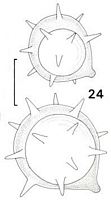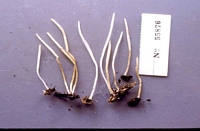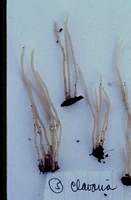|
 Clavaria echinoolivacea Clavaria echinoolivacea
SynonymsClavaria gibbsiae var. tenuis f. microspora
BiostatusPresent in region - Indigenous. Endemic
Images (click to enlarge)
Caption: Fig. 24 Clavaria echino-olivacea, spores, TENN no. 43686. Scale bar = 5 µm. | 
Caption: Microfiche 1-15. Clavaria echino-olivacea. TENN no. 43607. | 
Caption: Microfiche 1-16. Clavaria echino-olivacea. TENN no. 43685. |
Article: Petersen, R.H. (1988). The clavarioid fungi of New Zealand. New Zealand Department of Scientific and Industrial Research, Bulletin 236: 170 pp. Wellington:.
Description: Fruit bodies up to 90 x 4 mm, simple clubs occurring singly or in small groups of up to 12
individuals arising from individual or common small white mycelial patches, very narrowly
fusiform to narrowly cylindrical, somewhat sinuate. Club off-white when young, in age buffy
("cartridge-buff"), pale greenish grey ("deep olive-buff" mostly, upward to "pale olive-buff"
or "olive-buff") to dull greenish yellow ("colonial buff"), appearing waxy; apex narrowly
rounded, often somewhat darker than club (in age?). Stipe white when young, then
concolourous with club ("deep olive-buff") or yellower ("mustard-yellow"), minutely shiny-silky. Taste and odour negligible.
Tramal hyphae hardly inflated, clampless. Subhymenium well-developed, pseudo-parenchymatous. Basidia 40-50 x 8-10 µm, bifurcate to clamped;
contents homogeneous to
multiguttulate (guttules highly refringent); sterigmata 4, slender, erect.
Spores (fig. 24) 7.2-9.0 x 6.5-9.0 µm (E = 1.00-1.16; Em = 1.07; Lm= 7.88 µm), globose to
subglobose, smooth to echinate, thin-walled; contents multiguttulate in youth, uniguttulate
by maturity, the guttule highly refringent and obscuring observation of the spore wall; hilar
appendix stout, papillate-truncate; ornamentation of narrowly conical to cylindrical spines
up to 2 µm long.
Habitat: Under kauri (Agathis australis) forest.
Notes: Only very careful observation will reveal the spiny spore wall, and this character would seem
to be the only one to separate Clavaria echino-olivacea from C. subsordida, with smooth
spores but virtually identical fruit bodies and micromorphology. Indeed, the latter may be
conspecific, but I have found no spiny spores.
Corner (1950; p. 238, footnote) found spiny spores in spirit-preserved material of Clavaria
gibbsiae var. tenuis t. micropora but dismissed them as contaminants. All other characters
match well, so I accept those spores as belonging to the fungus in question. Corner did not
know pale-coloured Clavaria taxa with spiny spores, and with the caveat repeatedly
presented here (under individual spiny-spored taxa) it is easy to accept his conclusion.
Ordinarily, nomenclatural recommendations would result in the form being raised to species
rank, but the epithet microspora is pre-empted by Clavaria microspora Josserand. Moreover,
I have not examined the type of Corner's taxon, and therefore I am reluctant to use it as the
type of this taxon. Therefore, I have proposed a new species, with Corner's forma as a
synonym.
It is necessary to piece together the original description of Corner's forma, combining the
macroscopic data from var. tenuis (Corner 1950; p. 237-238) except for spore data, and
forma microspora (Corner 1950; p. 238-239, especially the footnote). I assume that Corner's
plate 2 illustrates var. tenuis f. tenuis, not f. microspora.
Clavaria echino-olivacea is similar to C. californica Petersen, which produces similar fruit
bodies (white to pale dull yellow; "cartridge-buff") and ellipsoid spores.
Fruit bodies of TENN no. 43686 are brighter yellow than those of others, but micro
morphologically they are identical. Fruit body shape and habit (loosely cespitose from
individual or common mycelial patches) also match completely. The colour discrepancy
may be due to the age of the fruit bodies or to some micro-ecological variation, but I
consider the specimens to be contaxic.
|